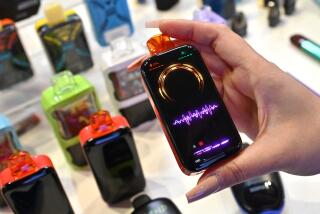A high-tech approach to getting a nicotine fix
- Share via
BEIJING — Hon Lik used to light up first thing in the morning. He smoked between lectures at the university where he studied Oriental medicine, between bites at lunch, in the lab where he researched ginseng health products. He’d usually burn through two packs by dusk and smoke a third over dinner and drinks with colleagues.
It wasn’t until his father, also a heavy smoker, died of lung cancer that Hon finally kicked the habit.
Hon’s story could be that of any other nicotine-addicted, middle-aged man in China, where 60% of the men smoke. What distinguishes the 52-year-old pharmacist and inventor is that he found inspiration in the addiction.
One of the strangest gizmos to come out of China in recent years, Hon’s invention, the electronic cigarette, turns the adage “where there’s smoke there’s fire” on its head.
It doesn’t burn at all. Instead, it uses a small lithium battery that atomizes a liquid solution of nicotine. What you inhale looks like smoke, but it’s a vapor similar to stage fog. (Take that, smoke-free bars!) It even has a red light at the tip that lights up with each drag.
“It’s a much cleaner, safer way to inhale nicotine,” said Hon, blowing curlicues of e-smoke as he showed off the cigarette in his Beijing office. (He says he doesn’t smoke anymore, except for such demonstrations.)
Hon got his first patent on the e-cigarette in 2003 and introduced it to the Chinese market the next year. The company he worked for, Golden Dragon Holdings, was so inspired that it changed its name to Ruyan (meaning “like smoke”) and started selling abroad.
This year, it’s planning a big push in the United States. A disposable e-cigarette called the Jazz ($24.95 for the equivalent of five packs) is due to hit 7-Elevens in the Dallas-Fort Worth area shortly. Many rival versions, all made in China, are making their way to the U.S., sold mostly over the Internet by small marketing firms.
Unlike nicotine patches and gum, electronic cigarettes are designed to be fun. There are regulars and menthols, as well as chocolate and strawberry. A company in Japan is selling one that is charged by the USB port of a computer.
The e-cigarettes aren’t marketed as a way to quit smoking, but as a smoking alternative.
“It’s safe smoking -- like smoking with a condom on,” said William Taskas, a Canadian distributor who is marketing a product called Smoke- Stik.
What makes the electronic cigarette more than just the latest curiosity from China is the enthusiasm it has inspired among respected anti-tobacco activists.
“This is exactly what the tobacco companies have been afraid of all these years, an alternative method of delivering nicotine that is actually enjoyable,” said David Sweanor, an adjunct law professor at the University of Ottawa who specializes in tobacco issues. “It took the Chinese, who are very entrepreneurial, and not burdened with all kinds of regulation, to take the risk.”
Even without smoke or fire, electronic cigarettes are sparking controversy. Australia, Canada and Hong Kong have banned them on the grounds that they have not been sufficiently tested for safety.
“The way they were being sold, there was no control. A kid could buy it and take too many puffs. You could overdose on nicotine,” said Ronald Lam, tobacco control chief of the health department in Hong Kong, where 800 shops were raided last month and the entire e-stash confiscated.
The Food and Drug Administration last month confiscated shipments from three Chinese companies on the grounds they were making false health claims. The agency said in a recent letter to prospective importers of electronic cigarettes that it had not decided on their legality, but was “evaluating them on a case-by-case basis.”
Although they’re not kicking Marlboro off the shelves in China, the electronic cigarettes have a small but loyal following.
“They’re quite popular with both men and women,” said Sun Shujuan, a clerk at the tobacco counter of the Beijing City Department Store. Each day, she sells one or two of the reusable cigarettes (a $145 appliance), and a much larger number of the replacement cartridges, which run $9 for the equivalent of five packs of cigarettes. “We have many repeat customers.”
Chinese smokers complain that the electronic cigarettes are expensive (most brands here are still less than $1 a pack) and can’t be easily shared. In China, cigarettes are the essential lubricant for opening a conversation -- the smoke offered to the cop who has pulled you over, the pack held open by a salesman approaching a prospect.
“What is the point of having cigarettes if you can’t give one to a friend?” said Liu Hai, who works as a driver and lives in Chengdu, in Sichuan province.
The United States is considered a far more promising market because of the higher price of cigarettes and the prohibition on smoking in many indoor spaces.
“When you’re in Minneapolis in the winter, it’s a lot more attractive to spend $24.95 on an electronic cigarette than it is to go out to smoke where it is 20 degrees below,” said Alex Chong, chief executive of Ruyan America, the Minneapolis-based U.S. affiliate of Hon’s company.
E-cigarettes are already sold legally in some British pubs, where smoking is banned.
Even though the devices are not yet widely available in the United States, the battle lines are being drawn.
The electronic cigarette marketers refrain from calling e-cigarettes a smoking-cessation aid -- in part because under U.S. law, if they made any health claims, they would be subject to FDA approval.
Bill Godshall, head of Smokefree Pennsylvania, estimates that at least 100,000 electronic cigarettes have been sold in the United States. (The gizmo got a boost last month when Leonardo DiCaprio was photographed smoking one on a bicycle.)
“You have these abstinence-only extremists who want to eradicate all nicotine product. But as you’ve seen, whether we’re talking about sex or alcohol or nicotine, abstinence doesn’t really work,” said Godshall, who has collected 4,000 signatures on a petition to allow e-cigarettes to be legally sold in the United States.
Chong, of Ruyan America, said his company was willing to put its product up for safety testing to win U.S. regulatory approval but not immediately, explaining that it is a $20-million, three-year process. He said that seven laboratories the company commissioned to test the product found no dangerous level of chemicals.
Inventor Hon says the idea of the electronic cigarettes came to him in a dream in 2000: Coughing and wheezing, he imagined he was drowning, until suddenly the waters around him lifted into a fog.
He gave one of the first prototypes to his dying father.
“It was too late for my father, but not for me. I switched over myself to electronic cigarettes.”
--
Nicole Liu of The Times’ Beijing Bureau contributed to this report.






